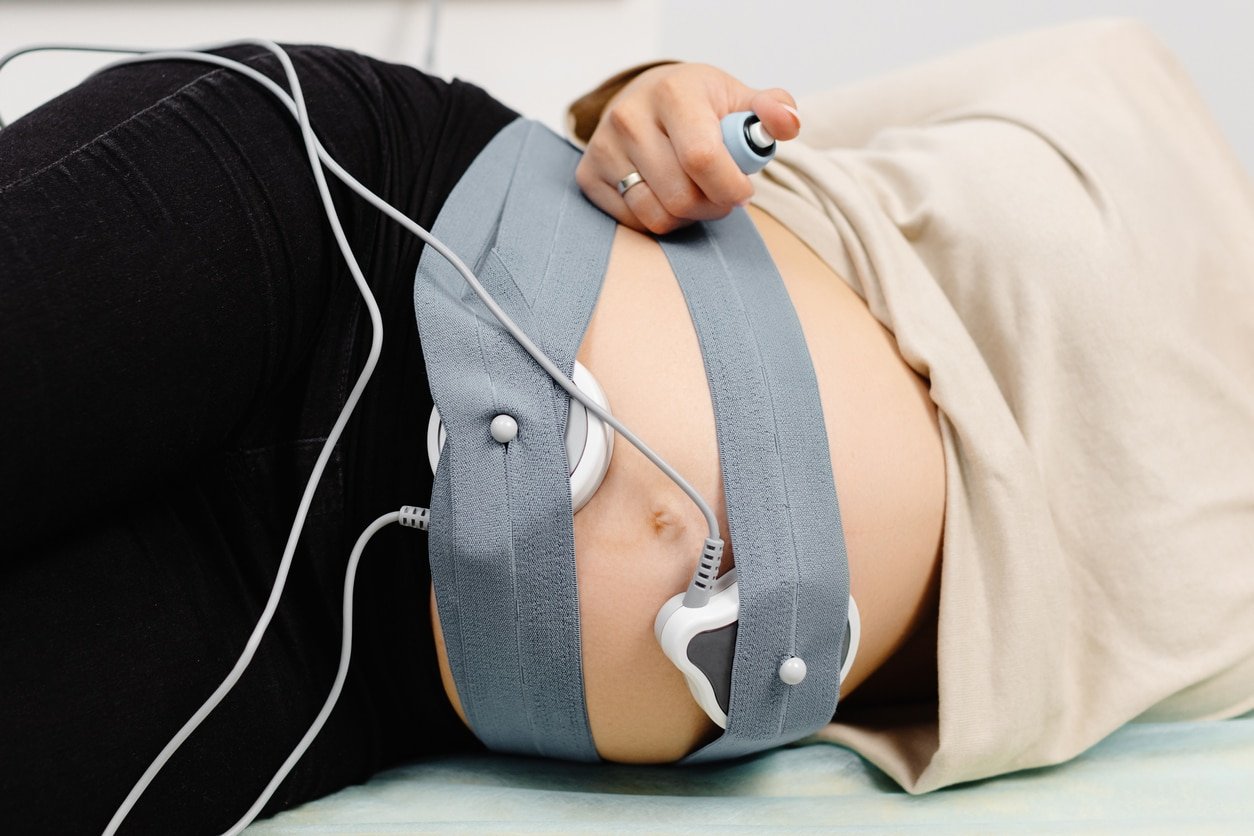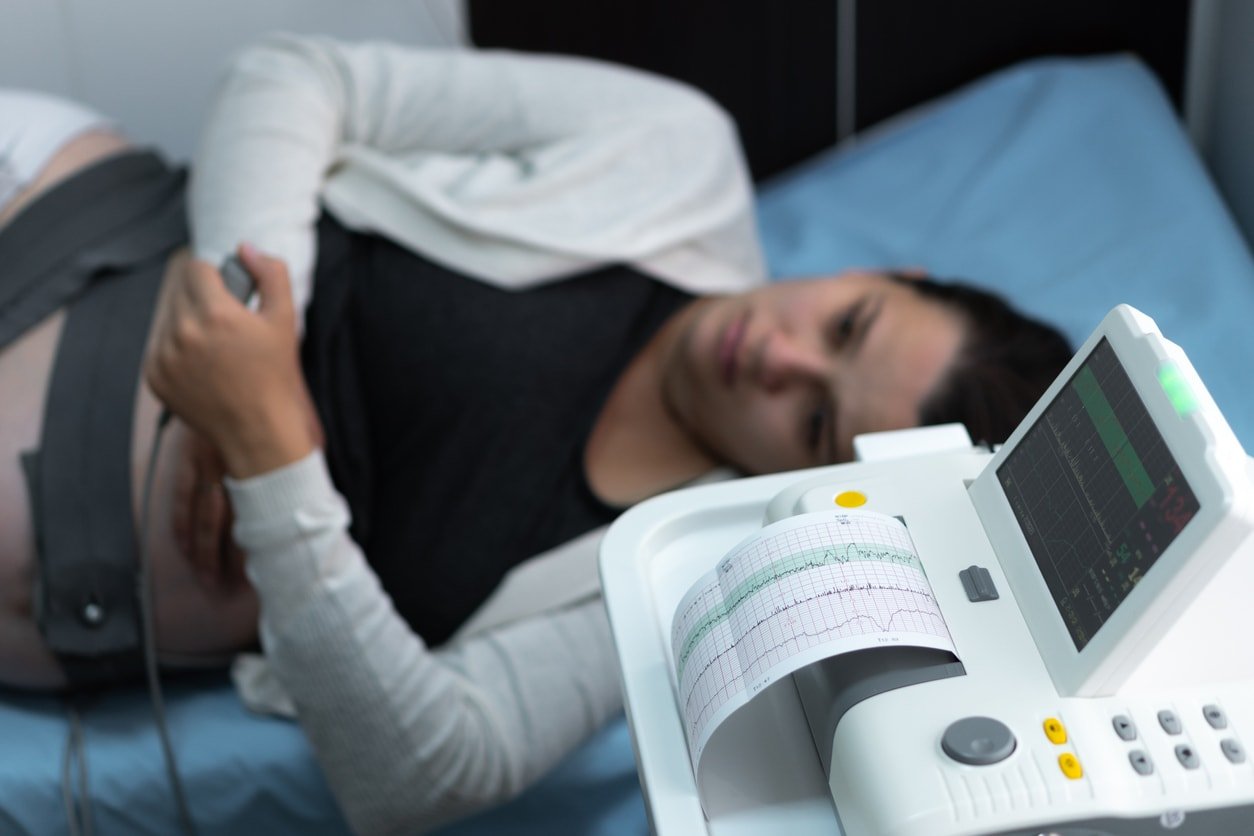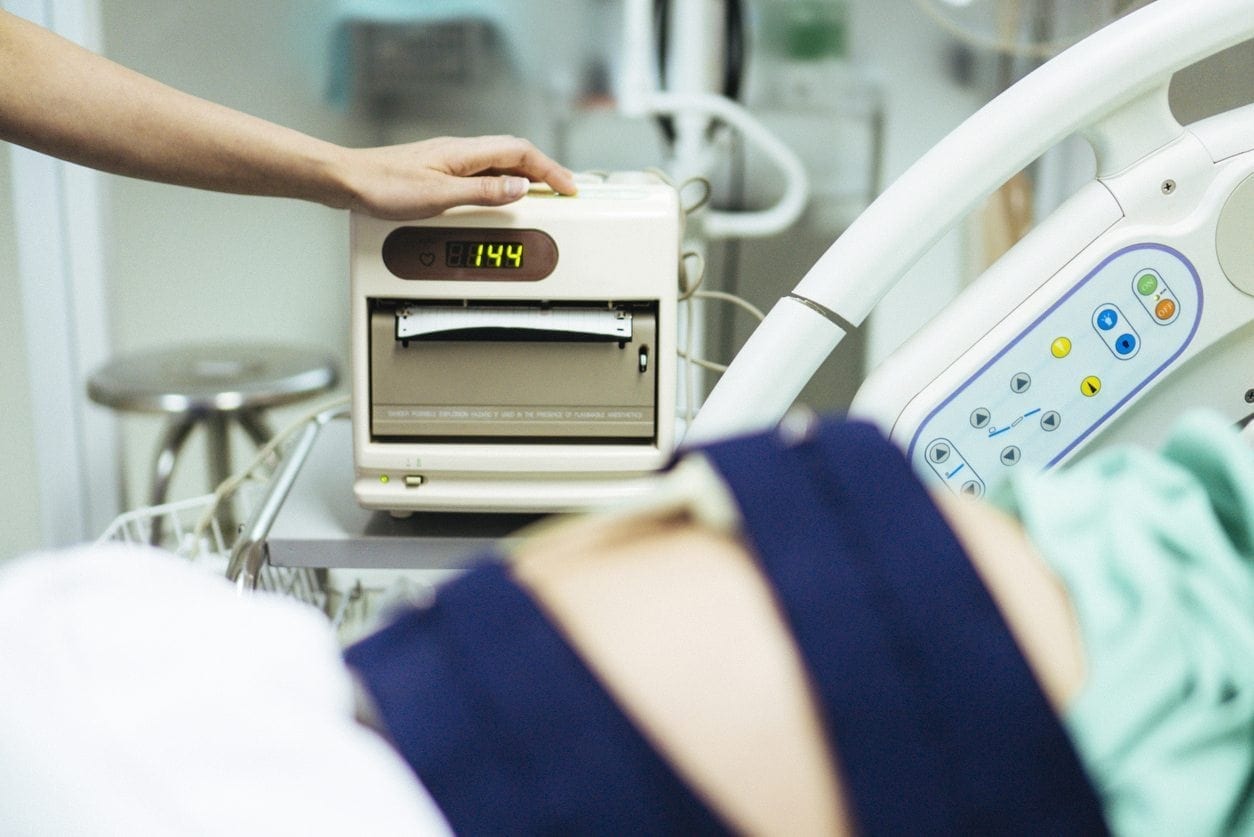When I was 33 weeks pregnant with my first daughter, I slipped on some black ice and fell down a flight of front porch steps. I had no severe injuries or any symptoms like bleeding or cramping. However, when I called my provider’s office to let them know what had happened, they brought me into the hospital immediately for a nonstress test and fetal monitoring. If you get called in for a nonstress test during pregnancy, knowing what to expect can be helpful. Here, we will explain what a nonstress test is, when and why they are done, what will happen during it, what the results mean, how it differs from other tests, and whether it is safe.
What Is a Nonstress Test?
Electronic fetal monitoring can detect pregnancy issues like placental disruption better than an ultrasound.1 One form of fetal monitoring is a nonstress test (NST), a simple way to check your baby’s well-being during pregnancy. It can sometimes detect early signs of something wrong with their circulation or nervous system. This data can be used with other information and tests to make decisions about delivery and other interventions when necessary.2,7
A nonstress test (NST) examines your baby’s heart rate and movements to measure your baby’s health and well-being before labor.2 It uses a cardiotocograph (CTG), also called electronic fetal monitoring (EFM), applied to your pregnant belly. The CTG measures a baby’s heart rate and kicks along with uterine contractions.3,4
Specific aspects of your baby’s heart rate that are examined during an NST include:3
- Base heart rate
- Heart rate variability
- Accelerations
- Decelerations
- Fetal heart rate vs. uterine contractions
- Accelerations vs. movement
When we move or exercise, our heart rate elevates. By the third trimester, the same should be true for your baby. Ideally, a nonstress test reveals that your baby’s movements coincide with an increased heart rate. This indicates that their neurological and cardiovascular systems are functioning and communicating appropriately.2
A nonstress test is one component of a biophysical profile, which also incorporates an ultrasound to examine heart rate, breathing, muscle tone, movement, and amniotic fluid.5
What Happens During a Nonstress Test?

A nonstress test can be performed in a doctor’s office or the hospital.2 You may be asked to lie on your left side.5,7 In my experience, I was seated in a slightly reclined position on a triage bed in the hospital.
A nurse or provider will place two monitors on your belly — one for the baby’s heartbeat and one for your contractions.3,7 They may apply some gel to the probes before placement. The monitors are held in place by stretchy bands or belts around your abdomen.5,7
You may be asked to press a button or otherwise indicate when you feel your baby move. The cardiotocograph may also be able to pick up on fetal movement.2,7 The monitoring of a nonstress test lasts at least 20 minutes, but the test may be extended depending on your baby’s cooperation and results.5,7
What Do the Results of a Nonstress Test Mean?
A nonstress test can be classified as “reactive” or “nonreactive.” The goal is to get a “reactive” result, meaning your baby’s heart reacts to their movements.2 To achieve a reactive stress test result, your baby must demonstrate two episodes of heart rate acceleration at 15 beats per minute above baseline, lasting 15 seconds within the 20 minutes of testing.2
If your baby is not considered reactive after 20 minutes, you should be monitored for longer — at least 40 minutes — because of the timing of a fetal sleep cycle.2 Noise and vibration can be used during this extended time to encourage your baby to move and their heart rate to accelerate.2 A device is placed over your belly near the baby’s head and emits a sound. This should stimulate your baby’s startle reflex and get them to move, sparking their heart rate to assure you and your providers of your baby’s well-being.6
False Positives Are Possible
Non-stress tests have a low false negative rate, meaning they do not miss a lot of issues. However, they have a high false positive rate, meaning they often identify issues where there are not any. This means that your baby will likely be fine even with an abnormal nonstress test result.3 Some possible reasons you may receive a false nonreactive result are that your baby is too young or they are sleeping.2 Results of a nonstress test during pregnancy will likely be verified with other tests before your doctor recommends any significant interventions, such as induction for early delivery.3
If a nonstress test is still nonreactive after 60 minutes, other tests may be performed, including:2
- Contraction stress test
- A full biophysical profile (BPP)
- Doppler ultrasound to look at blood flow through the placenta, umbilical cord, and fetus
- Continuous fetal monitoring
If the results of other tests are also concerning, your provider may recommend continued monitoring or even labor induction and delivery.2
Why Do You Need a Nonstress Test During Pregnancy?

There are many indications why you may need a nonstress test to check on your baby, and some women get NSTs once or twice per week in their third trimester.5 Most of the time, an NST is needed during high-risk pregnancies when the baby is at risk for low blood oxygen levels or fetal death/stillbirth. Some examples of this include:2
- Overdue baby
- Small baby
- Maternal diabetes, either preexisting or gestational
- High blood pressure and preeclampsia
- Decreased fetal movement
- Multiples pregnancy
- Low amniotic fluid
- Cholestasis
You may also receive a nonstress test if you have been involved in a car accident or had a fall during pregnancy. In these cases of physical trauma, you may be monitored for longer than the standard 20 minutes.2
When Are Nonstress Tests Done?
Your doctor may begin performing NSTs as early as 26 to 28 weeks of pregnancy, but they can be considered reactive starting at 32 weeks. Before 32 weeks, there is a high false positive (nonreactive) result for nonstress tests because the baby’s heart is not yet mature.2 Nonstress tests are often done in post-term pregnancies beyond 41 weeks to ensure the baby is still thriving past its due date.2,5
What Is the Difference Between a Nonstress Test and a Contraction Stress Test?
A nonstress test is purely observational — no intervention is involved, only monitoring. A contraction stress test looks at the same values as a nonstress test: fetal heart rate and fetal movement. In addition to monitoring, a contraction stress test also involves the administration of a medication, usually intravenous oxytocin/Pitocin, to cause the uterus to contract. This is done to observe how the baby tolerates contractions.3,7
A contraction stress test is time-consuming and presents a risk of preterm labor or uterine hyperstimulation in the setting of certain conditions:3
- Vaginal bleeding
- Placenta previa
- Preterm premature rupture of membranes (PPROM)
- History of preterm labor
Stress tests are not recommended for routine use due to little benefit and increased risk over other monitoring techniques:3
Are There Any Risks of a Nonstress Test During Pregnancy?
While pregnancy stress tests may be considered risky in certain patients, nonstress tests are very safe. There are not many risks associated with a nonstress test during pregnancy, as it is not interventional. No medications or other treatments are administered. It uses only an electronic fetal monitor to look at fetal heart rate and uterine contractions.3
In acute situations such as placental abruption or cord prolapse, there is a risk that an NST will waste valuable time in diagnosing a problem and intervening. Therefore, faster fetal evaluation is necessary, and NST should not be used.2
Finally, a nonstress test can limit mobility while the leads are attached to your belly. You may be uncomfortable, and there is a small risk that a nonstress test could cause low blood pressure or faintness if you are stuck sitting in a certain position for too long.2 If this happens to you, listen to your body and adjust your positioning as necessary. Your provider or nurse can reposition the monitors, even if that means starting the 20 minutes over again.
A nonstress test during pregnancy is a safe, low-intervention practice that can provide valuable information on how your baby is doing in the womb. It is not a perfect test — it can miss things or pick up on nonexistent issues — but in many cases, it provides good initial data and identifies when further testing might be warranted.






























